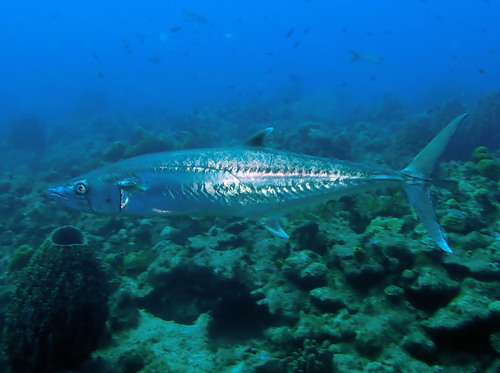
King Mackerel
The Bluefin Tuna (Thunnus thynnus, Thunnus orientalis, Thunnus maccoyii) are apex predators in the marine ecosystem, renowned for their size, speed, and migratory behavior. They are also among the most commercially valuable and overfished species.
24 26 years
Lifespan
185 cm
Length
Least Concern
Conservation Status
43 km/h
Swimming speed
Carnivorous
Diet
Highly Migratory, Seasonal Migration
Migration
Appearance Overview
The Bluefin Tuna is renowned for its large, streamlined body, built for speed and endurance.
Color
Dark metallic blue on top with a silvery underside
Second dorsal fin
Higher than the first one
Pectoral fins
Short compared to body size
Body shape
Torpedo-like
Length
Up to 10 feet (3 meters), commonly 6.5 feet (2 meters)
Weight
Up to 1,500 lbs (680 kg), commonly 550 lbs (250 kg)
Diet
Carnivorous, feeding on fish, squid, crustaceans, and eels.
Feeding Behavior
Uses speed and agility to chase down prey, often hunting in coordinated schools, especially when young.
Social Behavior
Highly migratory, forming large schools, particularly during spawning and feeding; schooling behavior diminishes with age.
Commercial Relevance
Extremely high value, particularly in sushi and sashimi markets, where it can fetch extraordinarily high prices per fish.
Conservation measures
International fishing quotas, catch limits, minimum size restrictions, and monitoring programs; some marine protected areas offer limited protection.
Status
Varies by species: Atlantic Bluefin (Endangered), Pacific Bluefin (Vulnerable), Southern Bluefin (Critically Endangered).
Threats
Severe overfishing driven by high demand, illegal and unreported fishing, bycatch in other fisheries, and slow maturation rates.
Habitat Distribution
Depth Range
0-9842 feet (0-3000 meters), most commonly in the upper few hundred meters.
Geographic Range
Atlantic, Pacific, and Southern Oceans; Mediterranean Sea.
Preferred Environment
Temperate and subtropical waters; open ocean (pelagic), often near continental shelves and slopes.
Reproduction and Life Cycle
Breeding Habits
Spawns in specific areas, such as the Gulf of Mexico and the Mediterranean Sea, with spawning times varying by region; broadcast spawners.
Development Stages
Eggs hatch into larvae; rapid growth in the first few years; juveniles develop into adults over several years.
Fecundity
Females can produce millions of eggs per spawning season (up to 30 million), depending on size and age.
Maturity Age
Matures at 4-8 years for Atlantic Bluefin, 3-5 years for Pacific, and 8-12 years for Southern Bluefin, though this is variable.
Faqs about King Mackerel
How fast can Bluefin tuna swim?
Bluefin tuna are among the fastest fish in the ocean, capable of bursts of speed up to 43 mph (70 km/h).
How long do Bluefin tuna live?
They can live up to 40 years, although this is becoming rarer due to overfishing.
Are Bluefin tuna warm-blooded?
Bluefin tuna are warm-blooded, which allows them to maintain a higher body temperature than the surrounding water, aiding in muscle efficiency and speed.
Is it ethical to eat Bluefin tuna?
Yes, but it's crucial to source it from sustainable fisheries that adhere to strict catch limits and regulations to ensure the survival of the species.
What is the most expensive Bluefin tuna ever sold?
The record price for a single Bluefin tuna is over $3 million, paid at a Tokyo fish auction.
How far do bluefin tuna migrate?
Bluefin tuna undertake extensive migrations across oceans for feeding and spawning, sometimes traveling thousands of miles.
What does bluefin tuna taste like?
Bluefin tuna meat is prized for its rich, fatty texture and flavor, often used in sushi and sashimi. The belly meat, or 'toro', is the most highly valued.
Copyright @ Nature Style Limited. All Rights Reserved.
 English
English